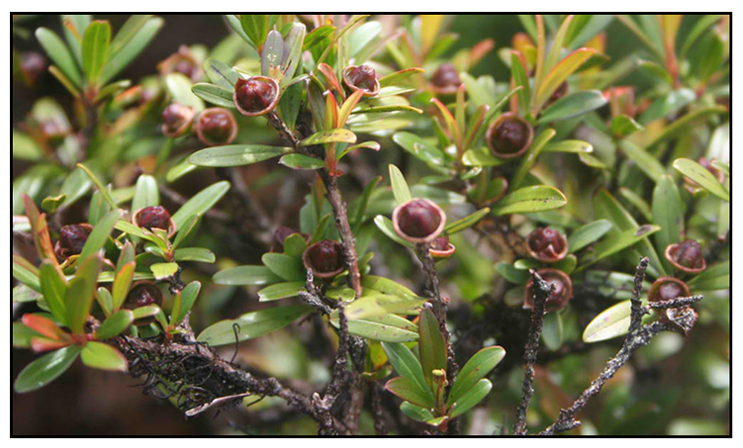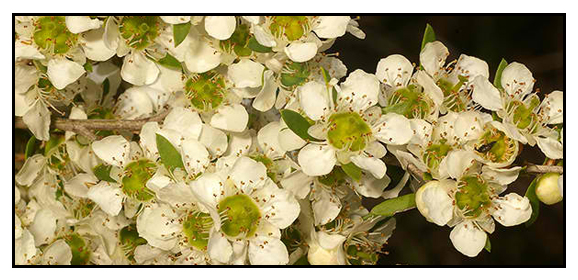
Family • Myrtaceae
Malasulasi
Leptospermum polygalifolium Salisb.
TEA TREE
| Scientific names | Common names |
| Glaphyria sericea Jack | Paripiñgin (Neg.) |
| Leptospermum acutifolium Otto & Dietr. | Malasulasi (Tag.) |
| Leptospermum aquaticum Otto & Dietr. | Tinikaran (Bag.) |
| Leptospermum blumei Steud. | Common tea tree (Engl.) |
| Leptospermum buxifolium H.L.Wendl. | Tantoon tea tree (Engl.) |
| Leptospermum flavescens Sm. | |
| Leptospermum nervosum Otto & Dietr. | |
| Leptospermum obtusum Sweet ex G.Don | |
| Leptospermum polygalifolium Salisb. | |
| Leptospermum porophyllum Cav. | |
| Leptospermum retusum Otto & A.Dietr. | |
| Leptospermum roseum Otto & A.Dietr. | |
| Leptospermum thea (Schrad. & J.C.Wedl.) Muhl. ex. Willd. | |
| Leptospermum tuberculatum Poir. | |
| Melaleuca aromatica Dum.Cours. | |
| Melaleuca thea Schrad. & J.C.Wendl. | |
| Leptospermum polygalifolium Salisb. is an accepted name The Plant List | |
| Leptospermum flavescens is a synonym of Leptospermum polygalifolium. | |
| Leptospermum is derived from the Greek words leptos (thin) and sperma (seed, referring to the small seeds). Polygalifolium is derived from the Latin word folius (a leaf, i.e., leaves resembling the genus Polygala). (4) | |
| Other vernacular names |
| AUSTRALIA: Tantoon. |
| INDONESIA: Gelam bukit, Hurong |
| MALAYSIA: Gelam bukit, Cina maki, Serai kayu wangi. |
Last Update January 2016
![]()
 |
| IMAGE SOURCE:Fruiting twig / Copyright © 2011 by Leonardo L. Co (contact: benctan@berkeley.edu) [ref. DOL28707]/ Non-Commercial Use / Click on photo to go to source page / Phytoimages.siu.edu |
| OTHERS MAGE SOURCE: Phot / Flowers / © Brian Walters / Non-Commercial Use / Click on photo to go to source page / Australian Native Plants Society |
| Additional
Sources and Suggested Readings (1) Leptospermum flavescens / Common names / GLOinMED (2) Antidiabetic Activity of Aqueous Extract of Leptospermum flavescens in Alloxan Induced Diabetic Rats / (Aktiviti Antidiabetik Ekstrak Akues Leptospermum flavescens dalam Tikus Diinduksi Aloksan) / ASMAWATI ABD RAHIM, JAMALUDIN MOHAMAD* & ZAZALI ALIAS / Sains Malaysiana 43(9)(2014): 1295–1304 (3) Leptospermum polygalifolium Salisb. / Synonyms / The Plant List (4) Leptospermum polygalifolium / Australian Native Plants Society (5) 2-Hydroxyflavanones from Leptospermum polygalifolium subsp. polygalifolium Equilibrating sets of hemiacetal isomers / Kamarul'Ain Mustafa, Nigel B Perry, Rex T Weavers / Phytochemistry, 01/2004; 64(7):1285-93. / DOI: 10.1016/j.phytochem.2003.09.006 (6) Flavonoids, phenolic acids and abscisic acid in Australian and New Zealand Leptospermum honeys / Lihu Yao, Nivedita Datta, Francisco A Tomás-Barberán, Federico Ferreres, Isabel Martos, Riantong Singanusong / Food Chemistry, 03/2003; 81(2):159-168 / DOI: 10.1016/S0308-8146(02)00388-6 (7) Leptospermum flavescens Constituent-LF1 Causes Cell Death through the Induction of Cell Cycle Arrest and Apoptosis in Human Lung Carcinoma Cells / Suerialoasan Navanesan, Norhanom Abdul Wahab, Sugumaran Manickam, Kae Shin Sim / / DOI: 10.1371/ journal.pone.0135995 |
| It is not uncommon for links on studies/sources to change. Copying and pasting the information on the search window or using the DOI (if available) will often redirect to the new link page. |
• |
 |
• |

 Botany
Botany
